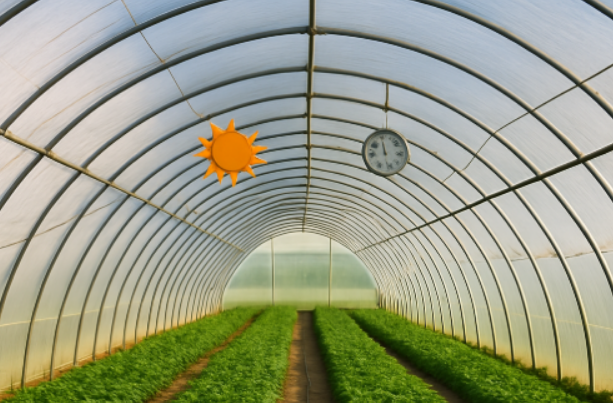An old belief exists among producers and farmers: “1% more light brings 1% more yield.” Recent scientific studies have shown that this saying is largely accurate. In this article, we intend to offer solutions to ensure proper greenhouse lighting so that you can reap the benefits of adequate greenhouse light.
Studies suggest that, depending on the crop type, a slight increase in light—somewhere between 0.5% and 1.25%—can boost yield. The key principle is that the more light available to the plant, the better its growth and quality. However, the first and most important requirement for achieving higher-quality and greater yield is providing sufficient and suitable greenhouse lighting.
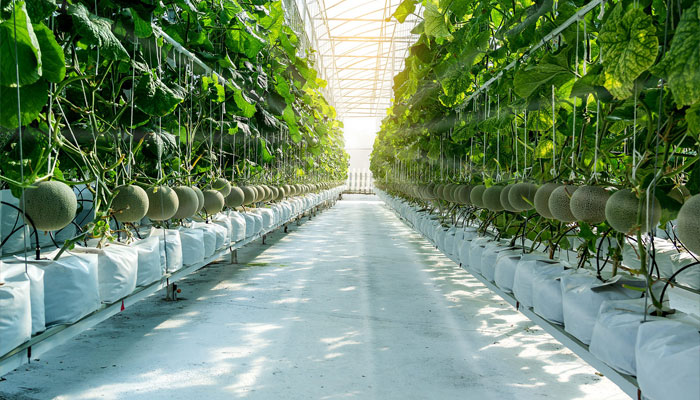
Three Solutions for Providing Light to the Greenhouse
In covered cultivation, such as in greenhouses, the covering significantly obstructs light reaching the plants and always reduces light levels. Therefore, controlling and supplying greenhouse lighting is one of the most critical tasks for improving greenhouse productivity. Fortunately, there are many tools to minimize greenhouse light loss. Follow along to discover three ways to boost greenhouse lighting:
- Keep the greenhouse covering clean
Over time, the greenhouse covering becomes dirty both inside and out. Algae, moss, dust, sand, pollution, and more accumulate on the covering, reducing greenhouse light and, ultimately, production. Moreover, contaminants on the greenhouse film become potential sources of pathogens. Therefore, regularly cleaning and disinfecting the covering not only significantly improves light transmission but also prevents disease from affecting the plants.
If the greenhouse covering lacks sufficient durability, frequent cleaning could reduce its lifespan. Therefore, using multi-layer greenhouse films with higher strength and longevity is recommended; these allow you to safely increase greenhouse lighting.
- Prevent interior condensation to increase greenhouse lighting
The covering often becomes very humid inside because the interior is warmer than the outside, leading to condensation—especially noticeable on cold days. Condensation on the covering can reduce light transmission by up to 20%. Therefore, using anti-fog greenhouse film that prevents water droplets from forming on the covering is advisable to maintain optimal lighting.
- Reducing reflection from the greenhouse covering affects light transmission
Much of the sunlight passes through the greenhouse covering and reaches the plant; however, some light is reflected away and lost—especially on cloudy days or during shorter daylight periods. Anti-reflective additives—composed of a thin layer of nano-particles—can increase light transmission by an average of 2.5% to 3%, ensuring the required light levels inside the greenhouse.
All three of these steps significantly impact greenhouse lighting, potentially resulting in up to a 10% increase in yield and healthier crops. These measures support lighting provision and, besides boosting production, also help reduce energy consumption.
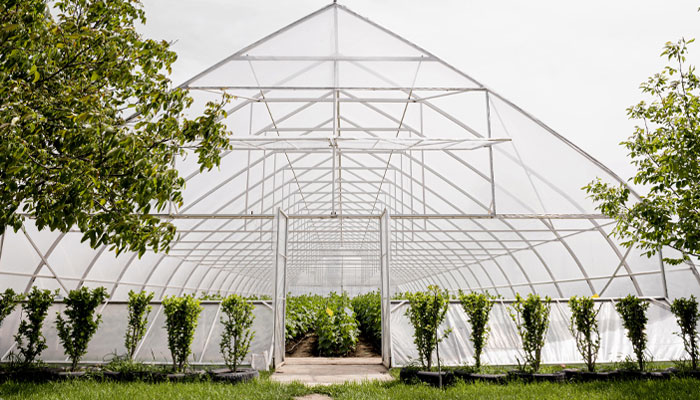
How to Provide Proper Light for Your Greenhouse
Villa homes with large yards and lush gardens are becoming a thing of the past. Life has been confined to small apartments, and urban and industrial expansion has distanced people from nature and green spaces. As a result, there’s growing interest in ornamental and houseplants, and enthusiasts are turning to building small and large greenhouses.Among the many crucial aspects of greenhouse construction—such as maintaining ideal temperature and humidity, providing suitable soil, and supplying CO₂—there’s a more fundamental challenge: providing appropriate lighting for the greenhouse.
Whether small or large, a greenhouse cannot always rely on sufficient natural sunlight. Plants require light for growth, nutrition, and photosynthesis, making proper lighting essential. This article will explain how you can use grow lamps to create artificial lighting that keeps your greenhouse vibrant and thriving.
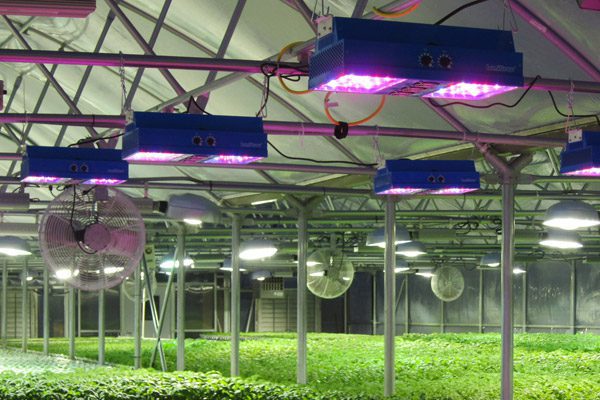
General Benefits of Using Artificial Light for Greenhouses
When used correctly, greenhouse lighting offers significant benefits and can be an effective substitute for sunlight. Artificial grow lights allow you to create an attractive, customized growing environment. These lights produce electromagnetic spectra ideal for photosynthesis, stimulating plant growth.
Using artificial lighting to enhance yield and quality is common. Many greenhouses rely on this approach during winter to produce vegetables, prevent plant weakening, and grow ornamental flowers. This method—known as “cool lighting”—does not harm plants like intense sunlight can.
Artificial light can improve growth factors, depending on crop type, environment, and light scheduling. Plants also require periods of light and darkness, and artificial lighting allows you to schedule these cycles precisely.
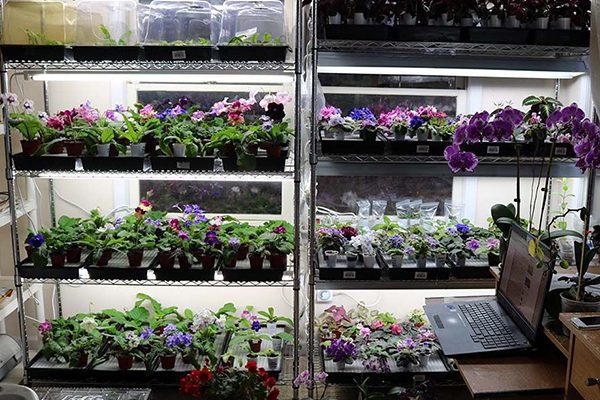
Photoperiods in Plants
Based on their response to light and dark periods, plants are categorized into three groups:
- Long-day plants: These plants require at least 10 to 14 hours of light to flower. If darkness periods lengthen, they shift from reproductive to vegetative and stem growth. Examples include lilies, petunias, zinnias, and poppies.
- Short-day plants: These need less than 12 hours of light to transition from vegetative growth to reproductive growth and fruiting. Chrysanthemums are a classic example.
- Day-neutral plants: Flowering time in these plants is independent of photoperiod length, although increased light periods can speed up growth and improve flower quality. Examples include begonias, gerberas, carnations, and many vegetables.
An old belief exists among producers and farmers: “1% more light brings 1% more yield.” Recent scientific studies have shown that this saying is largely accurate. In this article, we intend to offer solutions to ensure proper greenhouse lighting so that you can reap the benefits of adequate greenhouse light.
Studies suggest that, depending on the crop type, a slight increase in light—somewhere between 0.5% and 1.25%—can boost yield. The key principle is that the more light available to the plant, the better its growth and quality. However, the first and most important requirement for achieving higher-quality and greater yield is providing sufficient and suitable greenhouse lighting.

Three Solutions for Providing Light to the Greenhouse
In covered cultivation, such as in greenhouses, the covering significantly obstructs light reaching the plants and always reduces light levels. Therefore, controlling and supplying greenhouse lighting is one of the most critical tasks for improving greenhouse productivity. Fortunately, there are many tools to minimize greenhouse light loss. Follow along to discover three ways to boost greenhouse lighting:
- Keep the greenhouse covering clean
Over time, the greenhouse covering becomes dirty both inside and out. Algae, moss, dust, sand, pollution, and more accumulate on the covering, reducing greenhouse light and, ultimately, production. Moreover, contaminants on the greenhouse film become potential sources of pathogens. Therefore, regularly cleaning and disinfecting the covering not only significantly improves light transmission but also prevents disease from affecting the plants.
If the greenhouse covering lacks sufficient durability, frequent cleaning could reduce its lifespan. Therefore, using multi-layer greenhouse films with higher strength and longevity is recommended; these allow you to safely increase greenhouse lighting.
- Prevent interior condensation to increase greenhouse lighting
The covering often becomes very humid inside because the interior is warmer than the outside, leading to condensation—especially noticeable on cold days. Condensation on the covering can reduce light transmission by up to 20%. Therefore, using anti-fog greenhouse film that prevents water droplets from forming on the covering is advisable to maintain optimal lighting.
- Reducing reflection from the greenhouse covering affects light transmission
Much of the sunlight passes through the greenhouse covering and reaches the plant; however, some light is reflected away and lost—especially on cloudy days or during shorter daylight periods. Anti-reflective additives—composed of a thin layer of nano-particles—can increase light transmission by an average of 2.5% to 3%, ensuring the required light levels inside the greenhouse.
All three of these steps significantly impact greenhouse lighting, potentially resulting in up to a 10% increase in yield and healthier crops. These measures support lighting provision and, besides boosting production, also help reduce energy consumption.

How to Provide Proper Light for Your Greenhouse
Villa homes with large yards and lush gardens are becoming a thing of the past. Life has been confined to small apartments, and urban and industrial expansion has distanced people from nature and green spaces. As a result, there’s growing interest in ornamental and houseplants, and enthusiasts are turning to building small and large greenhouses.Among the many crucial aspects of greenhouse construction—such as maintaining ideal temperature and humidity, providing suitable soil, and supplying CO₂—there’s a more fundamental challenge: providing appropriate lighting for the greenhouse.
Whether small or large, a greenhouse cannot always rely on sufficient natural sunlight. Plants require light for growth, nutrition, and photosynthesis, making proper lighting essential. This article will explain how you can use grow lamps to create artificial lighting that keeps your greenhouse vibrant and thriving.

General Benefits of Using Artificial Light for Greenhouses
When used correctly, greenhouse lighting offers significant benefits and can be an effective substitute for sunlight. Artificial grow lights allow you to create an attractive, customized growing environment. These lights produce electromagnetic spectra ideal for photosynthesis, stimulating plant growth.
Using artificial lighting to enhance yield and quality is common. Many greenhouses rely on this approach during winter to produce vegetables, prevent plant weakening, and grow ornamental flowers. This method—known as “cool lighting”—does not harm plants like intense sunlight can.
Artificial light can improve growth factors, depending on crop type, environment, and light scheduling. Plants also require periods of light and darkness, and artificial lighting allows you to schedule these cycles precisely.

Photoperiods in Plants
Based on their response to light and dark periods, plants are categorized into three groups:
- Long-day plants: These plants require at least 10 to 14 hours of light to flower. If darkness periods lengthen, they shift from reproductive to vegetative and stem growth. Examples include lilies, petunias, zinnias, and poppies.
- Short-day plants: These need less than 12 hours of light to transition from vegetative growth to reproductive growth and fruiting. Chrysanthemums are a classic example.
- Day-neutral plants: Flowering time in these plants is independent of photoperiod length, although increased light periods can speed up growth and improve flower quality. Examples include begonias, gerberas, carnations, and many vegetables.

